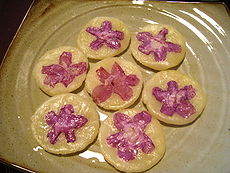- Hwajeon
-
Hwajeon 
Jindallae hwajeon (azalea jeon or tteok)Origin Place of origin Korea Region or state Korean-speaking areas Dish details Main ingredient(s) jeon (pancake) or tteok (rice cake), edible flower petals Hwajeon Hangul 화전 Hanja 花煎 Revised Romanization hwajeon McCune–Reischauer hwajŏn Hwajeon (Korean pronunciation: [hwadʑʌn]) is a small, sweet pancake or tteok (rice cake) made of any edible flower petals such as azalea or chrysanthemum and glutinous rice flour, and sugar in Korean cuisine.[1][2] Its name means "flower cake" in Sino-Korean, and also can be referred to as kkot bukumi (꽃부꾸미), kkot jijimi (꽃지지미), kkot darim (꽃달임) in native Korean language.[3]
Contents
Hwajeon nori
Hwajeon was commonly eaten at hwajeon nori (화전놀이), a traditional custom held since the Goryeo dynasty (918-1392), literally meaning "flower cake play".[4] In spring, women went on a picnic carrying with them glutinous rice flour and beoncheol (번철, a thick frying pan photo) near a stream on Samjinnal which falls on every March 3 in the lunar calendar. They plucked azaleas or any available edible flowers at hand where they set up their picnic and made hwajeon with the ingredients. The version made with edible azaleas (Rhododendron mucronulatum) is called jindallae hwajeon (진달래화전) or dugyeon hwajeon (두견화전, 杜鵑花煎), and is regarded as the most representative hwajeon.[3] It was traditionally eaten together with jindallae hwachae, or traditional punch consisting of the same flower floating in honeyed water or omija juice (Schisandra chinensis berries).[5][6]
Similarly, people enjoyed hwajeon nori in autumn as making another variety of hwajeon that is made with chrysanthemum flowers and leaves. It is called gukhwajeon (국화전) and consumed with gukhwaju (국화주, rice wine made with the flower), or yuja hwachae (yuzu punch). Gukhwajeon is closely related to the Korean traditional festival called Junggu (중구 重九) or Juyangjeol (중양절). It falls on every 9th day of September in the Korean calendar.[7][8][9][10]
Ingredients and varieties
In addition to jindallae hwajeon and gukhwajeon, any seasonal flower can be made as hwajeon if edible.[1] Ihwajeon (이화전, 梨花煎, Korean pear flower cake),[1] beotkkot hwajeon (벚꽃화전, cherry blossom cake), jebikkot hwajeon (제비꽃화전 Viola mandshurica cake) are made and eaten in spring, On the other hand, jangmi hwajeon (장미화전) made with roses is eaten in early summer.[1] and maendrami hwajeon (맨드라미화전 Celosia cristata Linne cake) in autumn.[1]
If no actual flowers are available, water dropwort, ssuk, seogi, jujube may be used in their place to make a flower-like decoration on the kneaded dough.[3]
See also
References
- ^ a b c d e "Ttuk, Hangwa : Kinds of Rice Cakes". Pan-fried Rice Cake. Korea Agro-Fisheries Trade Corporation. http://www.foodinkorea.org/eng_food/korfood/korfood8_2.jsp. Retrieved 2008-06-28.
- ^ Chʻoe, Sang-su (1960). Hanʾguk ŭi sesi pʻungsok. Kyŏnggi Taehak Minsokhak Yŏnʼguso : Koryŏ Sŏjŏk Chusik Hoesa. pp. 54. http://books.google.com/books?id=Idc5AAAAMAAJ&q=hwajeon&dq=hwajeon&lr=&pgis=1.
- ^ a b c "화전 (花煎)" (in Korean). Empas / EncyKorea. http://100.empas.com/dicsearch/pentry.html?s=K&i=263451&v=42. Retrieved 2008-06-23.
- ^ "화전놀이 (花煎놀이), Hwajeon nori". The Academy of Korean Studies. http://www.aks.ac.kr/glossary/glossary_detail.asp?g_code=13545&page=1&c_code=&search_field=all&keyword=hwajeon&order=g_korean&kanada=. Retrieved 2008-06-28.
- ^ "Kind of Eumcheongryu". Hwachae (Honeyed juice mixed with fruits). Korea Agro-Fisheries Trade Corporation. http://www.foodinkorea.org/eng_food/korfood/korfood9_2.jsp. Retrieved 2008-06-28.
- ^ "Jindallae hwachae (진달래화채 ──花菜)" (in Korean). Empas / EncyKorea. http://100.empas.com/dicsearch/pentry.html?s=K&i=263413&v=43. Retrieved 2008-06-28.
- ^ Lee E-hwa; Ju-Hee Park (translation) (2006). Korea's pastimes and customs: A Social History. Homa & Sekey Books. pp. 170–172. ISBN 1931907382. http://books.google.com/books?id=HcsMRc6pbQoC&pg=PA170&dq=jung+yangjeol&ei=fmA4SJS3JIuOywTW0pSCBQ&sig=EXns-_iyp9WVyyKgLQddyJrIlkE. Retrieved 2008-05-24.
- ^ Shin Najeong (신나정) (2007-12-06). "Interesting Food Story (Yuja) (재밌는 푸드 이야기 (유자)" (in Korean). MBN Radio. http://ics1.mk.co.kr/icsView30.php?community_cd=mm147_v1&no=1&field=&key=&start=120&programCode=429. Retrieved 2008-05-24.
- ^ "(Korean Food Culture Series - Part 3) Special Food for Seasonal Occasions". Korea Tourism Organization. http://english.visitkorea.or.kr/enu/SI/SI_EN_3_6.jsp?gotoPage=1&cid=258922. Retrieved 2008-05-24.
- ^ Christian Roy (2005). Traditional Festivals: A Multicultural Encyclopedia. ABC-CLIO. pp. 116. ISBN 1576070891. http://books.google.com/books?id=IKqOUfqt4cIC&pg=PA116&dq=junggu+custom&as_brr=3&ei=0GE4SKSOFZCkzgS_8uG9Ag&sig=tPCkkkFyQ0Ml-hckl_9_GmiKZiA. Retrieved 2008-05-24.
- Chung, Hyeon-Mi (정현미). "(진달래 음식의 종류와 조리법 고찰) The Kind and Recipe of Korean Rosebay Food" (in Korean / English /Japanese). National Folk Museum of Korea. pp. 1–16p. http://www.nfm.go.kr/downfile/book_mag/408/life2001.pdf. Retrieved 2008-06-28.
External links
- Information about Samjinnal and Korean desserts
- (Korean) Information about and recipe for Hwajeon
- (Korean) Information about and recipe for Hwajeon
- (Korean) Information about and recipe for Hwajeon
- (Korean) Recipe of hwajeon
Jeon
Wikimedia Foundation. 2010.

